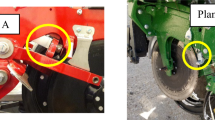Abstract
One experiment was conducted, through tensile tests of Albazzia and Eucalypt roots culled from the fields. The other experiment was conducted, by testing anti-drawing strength of these root systems in the Albazzia and Eucalypt lands. These two experiments had an aim to give insights into the maximum tensile strength and anti-drawing strength of the root systems. Results indicated that the maximum tensile strength of root system is in an exponential relation with the diameter of root system while the maximum tensile strength is positively correlative with the diameter of root system. Anti-drawing force of root system together with root diameter, length, and soil bulk density are folded into a regression equation in an attempt to figure out the static friction coefficient between root system and its ambient soil.
Similar content being viewed by others
References
Zhou Depei, Zhang Junyun,Engineering Technology of Slope Vegetation [M]. Beijing: China Communications Press, 2003:4–5 (Ch).
Wang Zhiguo, Zhang Yunlong, Liu Xushi,et al. Forest Ecological Engineering [M]. Beijing: China Forestry Publishing House, 2000:111–112 (Ch).
Wang Kejun, Lee C F. Brief Mechanics Analysis on Bioengineering Techniques for Slope for Protection [J].Chinese Journal of Rock Mechanics and Engineering, 1998,17(6): 687–691 (Ch).
Zhu Qingke, Cheng Lihua, Zhong Dongsheng,et al. Mechanisms of Soil-reinforcement by Roots in Forest Ecological Systems in Gongga Mountain [J].Journal of Beijing Forestry University, 2002,24(4):64–67 (Ch).
Guo Xiaoping, Zhu Jinzhao, Zhou Xincheng,et al. Technology and Application of Slope Bio-Technique [J].Science of Soil and Water Conservation, 1992,14(3):112–116 (Ch).
Cheng Hong, Zhang Xinquan. An Experimental Study on Herb Plant Root System for Strength Principle of Soil-Fixation [J].Bulletin of Soil and Water Conservation, 2002,22 (5):20–23 (Ch).
Jiang Zhongxin. The Technology of Prestress Anchoring Rope Reinforcing Landslide [J].Mountain Research, 1996,14(1):58–64 (Ch).
Xie Mingshu. A Study on Determining the effective limits of the Tree and Bush Roots Strength and the Best Distribution of Roots for Stable Slopes [J].Journal of Soil and Water Conservation, 1990,4(1):17–24 (Ch).
Author information
Authors and Affiliations
Corresponding author
Additional information
Foundation item: Supported by Plan of Tibet Autonomous Region State Ecological Safe Shelter Zone on the Tibet Plateau
Biography: YANG Yonghong (1973-), male, Post doctor, research direction: geological hazard prevention.
Rights and permissions
About this article
Cite this article
Yonghong, Y., Shuzhen, L., Chenghua, W. et al. A study of tensile strength tests of arborous species root system in forest engineering technique of shallow landslide. Wuhan Univ. J. Nat. Sci. 11, 892–896 (2006). https://doi.org/10.1007/BF02830183
Received:
Issue Date:
DOI: https://doi.org/10.1007/BF02830183




